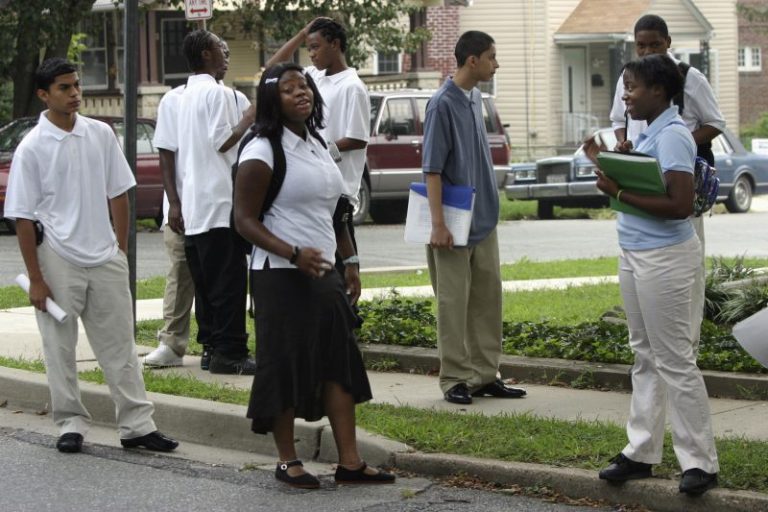Student dress codes are promoted by educators for security reasons, but in many cases they are a source of insecurity, especially for Black pupils, girls and other learners.
That’s a key finding in a federal watchdog report that says the government should be more active in pushing equal access to education by helping school districts design clothing standards that better consider equity and safety for students. Almost half of the nation’s schools enforce strict dress codes, though they are more common for Black and Latino students.
“Many dress codes include elements that may make the school environment less equitable and safe for students,” says a recent report by the Government Accountability Office (GAO). For example, GAO said, “an estimated 60 percent of dress codes have rules involving measuring students’ bodies and clothing — which may involve adults touching students.”
That can make girls feel less safe.
Hair also is a frequent target of dress codes that hit Black students more harshly than White ones. This is compounded by school disciplinary practices that are tougher on African Americans than White students for similar infractions. The result of unfair hair and clothing rules: “Black girls may be particularly vulnerable to harm from dress code enforcement,” the report said.
Consider the case of Ahriah Baynes, an Albany (N.Y.) High School athlete, who was told she and her predominantly Black teammates could not wear uncovered sports bras during a May track practice.
As my colleague Anne Branigin reported, the girls said a school official told them they were no longer allowed to practice while wearing sports bras without tops, because it was distracting to the male coaches. This blames girls for alleged behavior (or thoughts) by men. The coaches, Ahriah told the Federal Insider on Wednesday, “would never, ever, ever” act inappropriately toward the female athletes. Meanwhile, their male counterparts were allowed to practice shirtless, the 17-year-old senior said in a telephone interview.
This case demonstrates “how intersecting race and gender stereotypes can really come together to single out Black girls especially” for their appearance “and to shame them for their bodies and to treat them as sort of inherently inappropriate,” said Linda Morris, a lawyer with the American Civil Liberties Union (ACLU), which represented the girls along with the New York Civil Liberties Union.
More troubling than clothing restrictions, school rules on hair can essentially define Black people’s natural characteristics as inherently inferior to White people. Citing a 2017 Education Office for Civil Rights investigation, the GAO said the reasons a school prohibited Afro hair styles were simply “pretexts for discrimination.” The probe found a Peoria, Ariz. school allowed “long hair that grows down (the natural hair growth direction for most White people), but not long hair that grows out/up (the natural hair growth direction for most African American people).” The GAO also cited a school district that prohibited “hair with ‘excessive curls’ ” and another school system that blocked hair “no deeper than two inches when measured from the scalp” — regulations that more directly target Black students.
Other GAO examples of problematic dress code actions include:
• A Manatee County, Fla., high school girl who “was told to ‘move around’ for the school dean to determine if her nipples were visible through her shirt. The student was then instructed to put band aids on her chest.”
• A Pearland, Tex., school staffer who “drew on a Black boy’s head in permanent marker to cover shaved designs in his hair.”
• Victim shaming Huntington, W.Va., middle school girls who were “told they should not report inappropriate touching if they were not following the dress code.”
Some school districts seek to address equity issues by having students wear uniforms. But that can be difficult for low-income families “who may struggle to buy specific clothing items or afford certain hairstyles,” the GAO said. It found that almost three-fourths of predominantly Black schools require uniforms, as do just over half of predominantly Hispanic schools. That contrasts sharply with 2 percent of White schools.
The GAO does not condemn dress codes but does emphasize the need for equity and safety in their design and implementation. The punishment for violating dress codes can be suspension from school, which defeats learning and can lead to more serious issues.
More than 80 percent of predominantly Black schools and almost two-thirds of predominantly Hispanic schools enforce strict dress codes, compared to just over one-third of White schools, the GAO found. That fuels more suspensions, which can feed the school-to-prison pipeline. “Students who have been suspended are more likely to drop out of school and become involved in the juvenile justice system than their peers,” the GAO said, pointing to studies that “show Black and Hispanic students are more likely to receive harsher school discipline than their counterparts for the same violation.”
“Students are being denied educational opportunities because of what’s on their head … not in it,” said Michaele Turnage Young, senior counsel at the NAACP Legal Defense and Educational Fund. “We certainly shouldn’t be denying students an equal opportunity to get an education because their hair is curly.”
Education Department officials agreed with the GAO recommendations that they should provide resources to help schools design and implement dress codes that protect students’ privacy and promote equitable discipline.
Ahriah’s experience with dress codes has strengthened her desire to confront inequities head-on by becoming a lawyer and then a politician. She wants to go where she thinks the fight will be the hardest, by moving from liberal New York state to conservative Texas, because that’s where the challenges are the greatest.
“If you know me,” she said, “you know I love a good fight.”
She’s already won one. The school suspensions against her and her teammates was removed from their records, according to Morris, and the dress code was changed to allow sports bras in practice.

